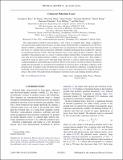Coherent polariton laser
Abstract
The semiconductor polariton laser promises a new source of coherent light, which, compared to conventional semiconductor photon lasers, has input-energy threshold orders of magnitude lower. However, intensity stability, a defining feature of a coherent state, has remained poor. Intensity noise at many times of the shot-noise of a coherent state has persisted, which has been attributed to multiple mechanisms that are difficult to separate in conventional polariton systems. The large intensity noise in turn limited the phase coherence. These limit the capability of the polariton laser as a source of coherence light. Here, we demonstrate a polariton laser with shot-noise limited intensity stability, as expected of a fully coherent state. This is achieved by using an optical cavity with high mode selectivity to enforce single-mode lasing, suppress condensate depletion, and establish gain saturation. The absence of spurious intensity fluctuations moreover enabled measurement of a transition from exponential to Gaussian decay of the phase coherence of the polariton laser. It suggests large self-interaction energies in the polariton condensate, exceeding the laser bandwidth. Such strong interactions are unique to matter-wave laser and important for nonlinear polariton devices. The results will guide future development of polariton lasers and nonlinear polariton devices.
Citation
Kim , S , Zhang , B , Wang , Z , Fischer , J , Brodbeck , S , Kamp , M , Schneider , C , Höfling , S & Deng , H 2016 , ' Coherent polariton laser ' , Physical Review X , vol. 6 , no. 1 , 011026 . https://doi.org/10.1103/PhysRevX.6.011026
Publication
Physical Review X
Status
Peer reviewed
ISSN
2160-3308Type
Journal article
Description
S. K., Z. B., Z. W., and H. D. acknowledge support from the National Science Foundation (NSF) under Grant No. DMR 1150593 and the Air Force Office of Scientific Research under Grant No. FA9550-15-1-0240. C. S., S. B., M. K., and S. H. acknowledge support from the State of Bavaria, Germany.Collections
Items in the St Andrews Research Repository are protected by copyright, with all rights reserved, unless otherwise indicated.

